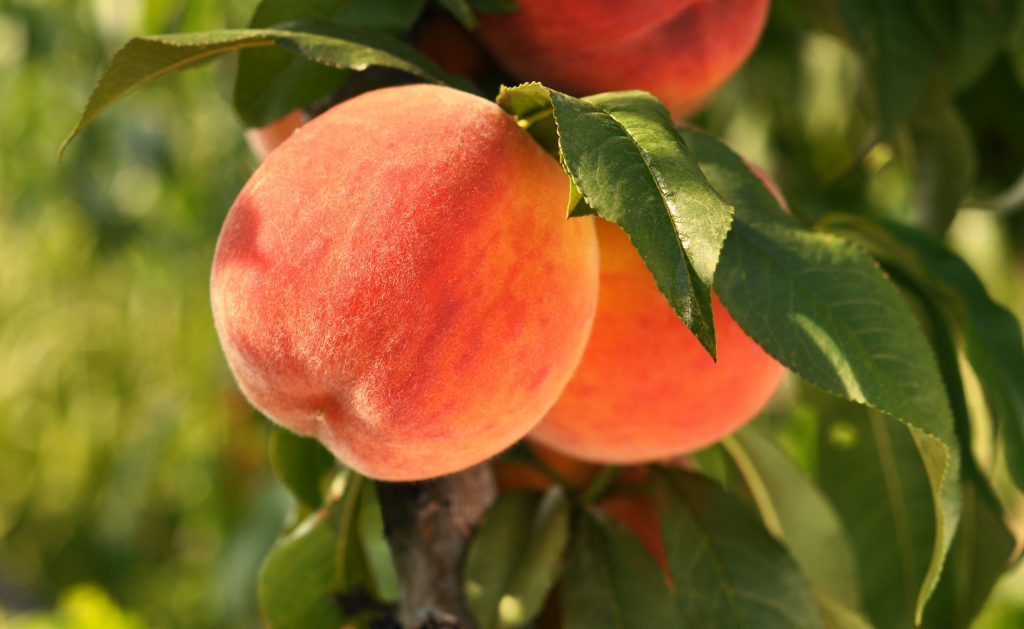
Many homeowners already enjoy the rewards of growing fruit bearing trees. Not only do these trees enhance the beauty of your landscape, they also provide your family with fresh, homegrown fruit for years to come.

General Considerations Prior to the Purchasing a Fruit Tree:
All fruiting trees require sunlight, ample space and good soil conditions. Most apple, European pear, plum and sweet cherry cultivars are not self-fertile – to produce the best fruit results, two different cultivars should be planted within 100 ft. of each other. This means that you will need two trees and ample space for both. Most peach, nectarine, apricot, sour cherry, and Asian pear are self-fertile and will therefore not require a second tree for fruit production, although some cultivars will produce more fruit with a companion tree. Feel free to consult our staff for guidance.
Space and Size
Final height and spread will depend on site conditions, pruning and maintenance. Most fruit trees are grafted cultivars.
- “Standard” trees mature around 15-30ft high; space 18-20 ft. between trees
- “Semi-dwarf” trees grow to about 15-20 ft.: space 12-15 ft. between trees
- “Dwarf” trees, including “genetic dwarfs” will be 10 -15 ft. when mature and should be planted at 8-10 ft. spacing.
- Most fruit trees can be pruned as an espalier or trained on a trellis to reduce space requirements.
- Dwarf trees may require staking to help support their fruit load.
Site Selection
Fruit trees grow best with at least 6 hours of direct sunlight a day. Select a site that allows air movement and is protected from strong winter winds.
Soil Needs
Most fruit trees will require well drained, neutral soil (pH of 6-7), and we recommend testing your soil prior to planting; here’s the link to the U Mass soil testing service.
Planting
Both container-grown and balled-&-burlapped (B&B) trees can be planted any time during the growing season. Follow the proper planting guidelines published on the Weston Nurseries website. In addition:
- Make sure roots stay moist during the planting process
- Incorporate phosphorus (0-20-0) supplement with the backfill soil, but avoid adding other fertilizer until the year following installation
- Stake your new tree to finish the planting process to stabilize it and encourage proper root regeneration
- Many fruit trees are grafted onto rootstock. Make sure the graft union stays visible above the final soil level. Some trees, particularly dwarf types, may be grafted in more than one location along the trunk.
Mulching
All fruit trees benefit from maintaining several inches of mulch around their base to suppress weeds and also to discourage rodents that can damage trunk and roots.
Watering
All fruit trees should be given adequate water through the growing season.
Fertilization
Follow the recommendations from your soil test service, and in general, avoid adding fertilizer until the next growing season. Late fall or early spring is the proper time for fertilizing fruiting trees, using any formulation you choose, following directions on the label. Avoid fertilizing in summer.

Pruning
Developing the proper branching framework is more important than encouraging fruiting when the tree is first planted. Consult a reliable reference book for pruning details to reduce the (unlikely) chances of big mistakes; and don’t be afraid to prune. It’s always best to prune in winter or early spring when the tree is dormant. Pruning tools should be sharp and cleaned with every use.
Here are some additional advantages of appropriate pruning:
- Helps control the shape and size of the tree
- Removes unnecessary growth and stimulates fruit production
- Allows sunlight to optimize growth, fruit size and quality
- Simplifies needed insect and disease management.
Thinning
Professional growers often physically reduce the number of fruit on their trees to help ensure better production, but for a home orchard, thinning immature fruit is an unnecessary bother. Recently planted trees should prioritize healthy vegetative growth rather than optimal fruit production. Mature fruit trees tend to naturally shed their excess fruit when properly maintained.
Diseases and pests
Some observations:
- Proper hygiene practices help reduce disease and pest problems and encourage best fruit production. Fallen leaves, branches and fruits can harbor fungus and insects (overwintering adults, larvae or eggs) and should be removed every autumn
- Pest management is a personal decision, and many options can be utilized, both organic and chemically.
- Apply netting over cherry trees to prevent birds from consuming fruit.
- Ask an expert at Weston Nurseries for specific recommendations, and always follow the directions on the package.









